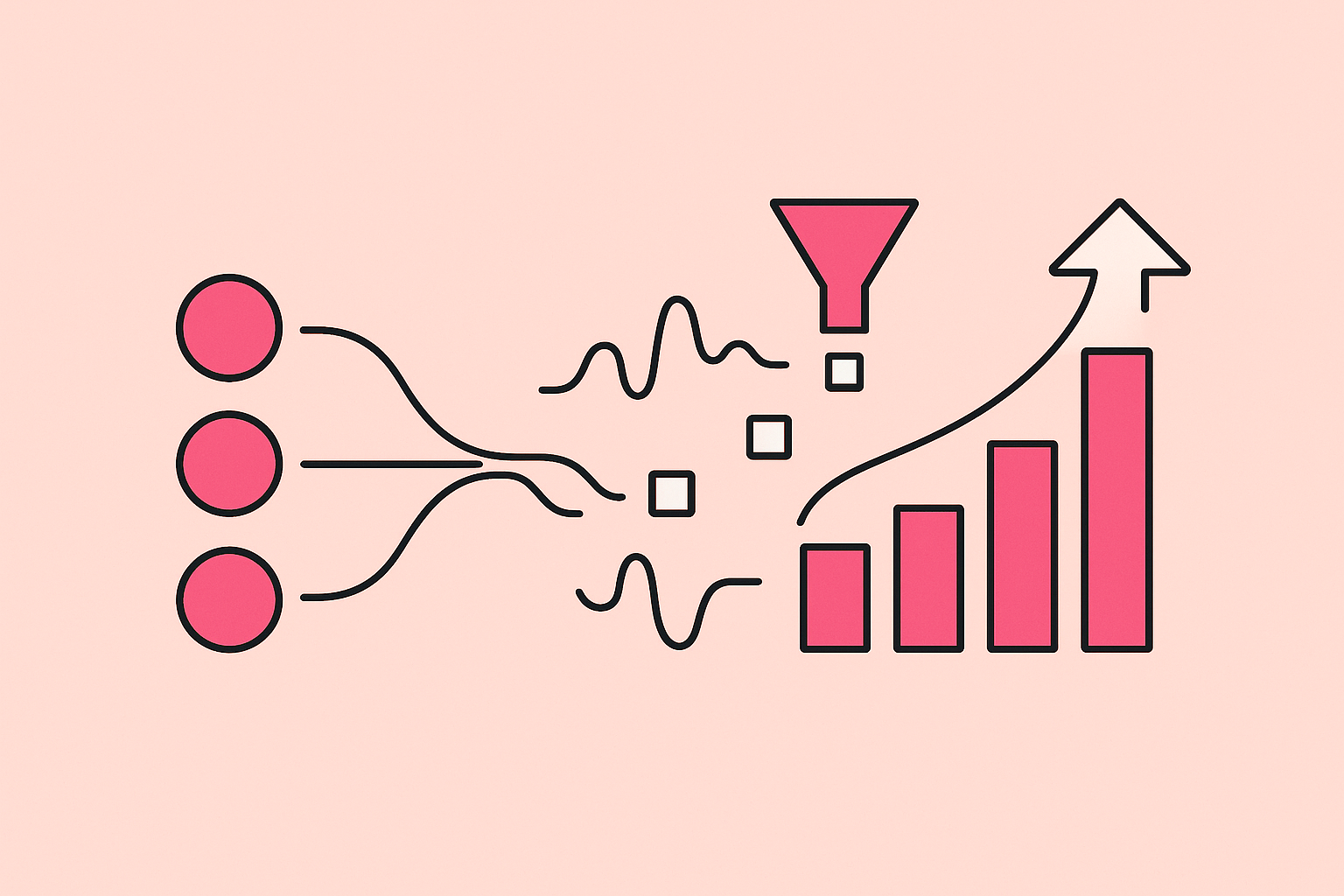
Most marketers obsess over downloads, but downloads are a vanity metric.
They tell you nothing about the pipeline. Nothing about revenue. Nothing about whether your podcast is driving business outcomes. Yet every Monday, marketing teams across B2B gather around dashboards, celebrating download spikes while their CEOs ask the only question that matters: "What's the ROI?" The uncomfortable silence that follows costs companies millions in misallocated budget and missed opportunities.
Here's the truth: podcast ROI isn't a mystery; it's a measurement problem. The difference between podcasts that generate pipeline and those that generate noise isn't production quality or guest fame. It's whether you're tracking the right KPIs. At Fame, after producing 100+ B2B podcasts, we've identified two distinct revenue paths that matter: guest-driven ROI (where strategic guest relationships convert to customers) and audience-driven ROI (where listeners become leads). Both are measurable. Both are predictable. Both require you to stop counting downloads and start counting dollars.
This strategic framework will transform how you measure podcast success. We've distilled years of B2B podcast data into a KPI-driven discipline that tracks real business outcomes. You'll discover the exact metrics that signal true ROI, learn how to implement attribution models that connect audio to revenue, and walk away with a complete dashboard template that proves podcast impact to your CFO.
Stop guessing. Start measuring what matters. Because when you implement the right Podcast ROI KPI frameworks, you don't just justify your podcast investment, you unlock a predictable revenue engine that compounds quarter over quarter. Let's build your measurement framework.
Foundation: Why Most Podcast ROI "Best Practices" Are Dead Weight
The Vanity Metric Trap: Why Downloads Aren't ROI
The podcast industry runs on marketing theater, not revenue science. While your competitors celebrate hitting 10,000 downloads, they can't answer the only question that matters: How much pipeline did those downloads generate? According to Edison Research, the average B2B podcast gets just 141 downloads per episode in its first 30 days, yet marketers still use this vanity metric as their north star.
Downloads don't connect to the pipeline because they measure reach, not impact. A thousand downloads from random listeners generates zero revenue, while three downloads from qualified prospects can yield six-figure deals. The disconnect happens because traditional podcast metrics were built for advertisers selling CPM rates, not B2B companies building relationships. When executives ask about Podcast ROI KPI frameworks, they're not asking about your listener count; they're asking about contribution to quarterly revenue targets.
Fame's knowledge base reveals a stark truth: relying solely on downloads is like judging a company's health by its website traffic alone, ignoring sales, customer retention, and profitability. The real metrics that matter? Guest-to-customer conversion rates, pipeline attribution, and content-influenced deals. These KPIs directly connect podcast activities to revenue outcomes, transforming your show from a content experiment into a measurable business asset.
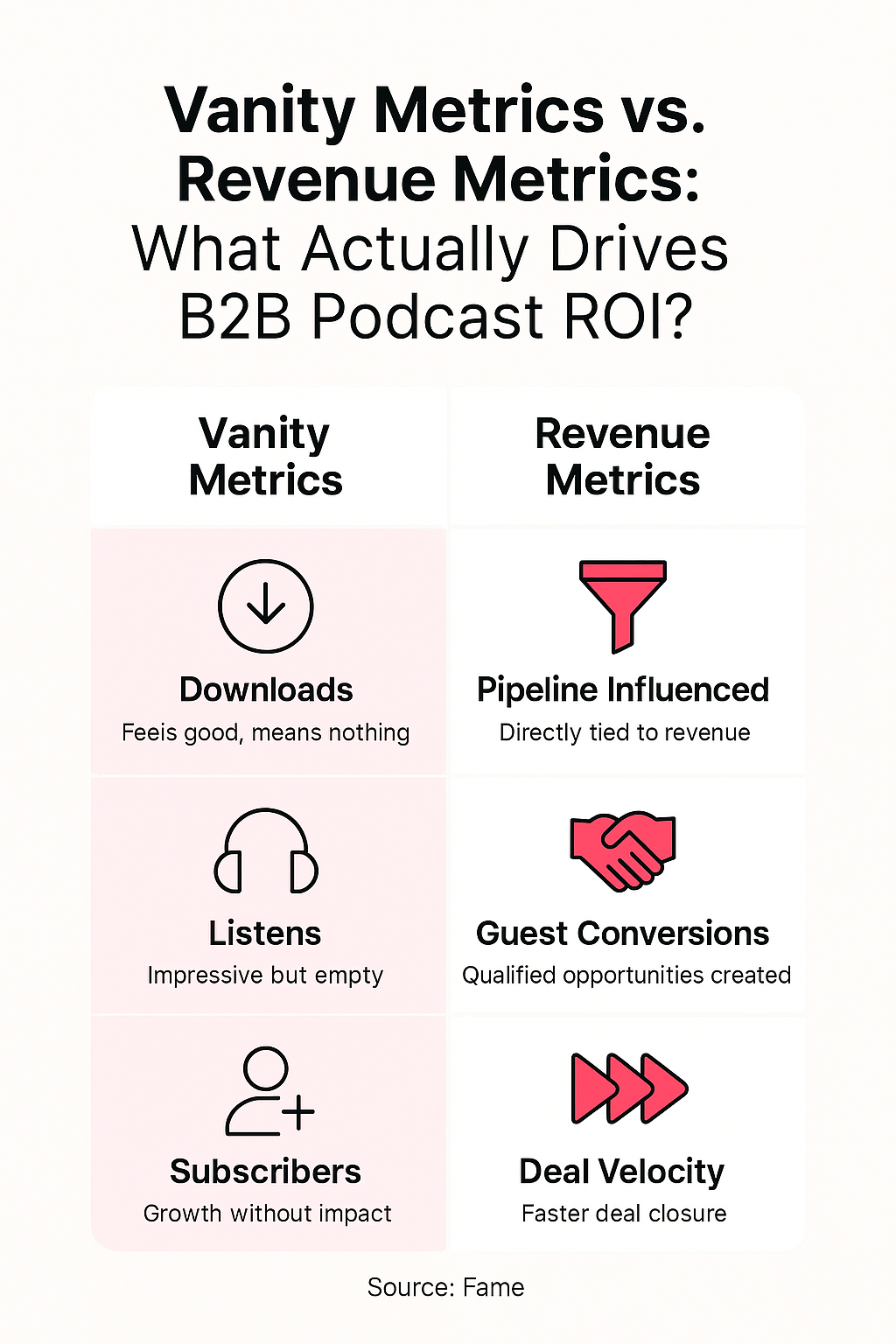
The Real Economics of B2B Podcasting
B2B podcasting operates on two distinct revenue engines: guest-driven and audience-driven paths. Fame's proprietary Two-Path ROI Model reveals why 82% of first-year podcast ROI comes from guest relationships, not audience growth. The math is simple: converting one strategic guest into a customer delivers more revenue than 10,000 anonymous downloads.
Consider the SOD podcast case study: They invested £5k in their podcast and closed a £50k deal with their 13th guest, a 9-10x ROI within months. The VP of Sales Operations at Intercom became a customer not because of download numbers, but because the podcast created a strategic relationship. This guest-driven approach delivers faster results because you're building trust with decision-makers who already fit your ideal customer profile, not waiting years for audience monetization.
Fame's data shows that B2B podcasts generate two distinct classes of ROI: short-term relationship-driven ROI through guest conversions and long-term audience-driven ROI through content influence. The critical insight? Year one ROI must come from strategic guest relationships. A $20K annual podcast investment that yields 10 potential customer relationships and 5 partnership opportunities can generate $15K per customer and $10K per partnership, creating cash-positive ROI that funds future audience growth.
The KPI Mindset: From Vanity to Value
Attribution-based measurement transforms podcasts from cost centers into revenue engines. The shift requires acknowledging that 65% of B2B podcast influence happens in dark social, LinkedIn DMs, Slack conversations, and water cooler mentions that traditional analytics miss entirely. Smart operators implement multi-touch attribution models that capture podcast touchpoints across the entire customer journey.
Effective Podcast ROI KPI tracking means tagging every guest interaction in your CRM, monitoring pipeline velocity for podcast-influenced deals, and implementing UTM parameters for all podcast-driven content. When Fame clients adopted this attribution framework, they discovered previously invisible revenue: one SaaS company found $340K in pipeline that sales had attributed to "direct" traffic was podcast-influenced. The KPIs that matter track dollars, not downloads.
According to Fame's metrics framework, successful B2B podcasts track Revenue per Download (RPD) as a critical financial metric. Unlike the common RPM (Revenue per Mille), RPD provides a direct, per-unit calculation of your podcast's commercial value. This shift from reach metrics to revenue metrics enables B2B brands to justify podcast budgets and prove value to stakeholders by connecting content directly to the bottom line.
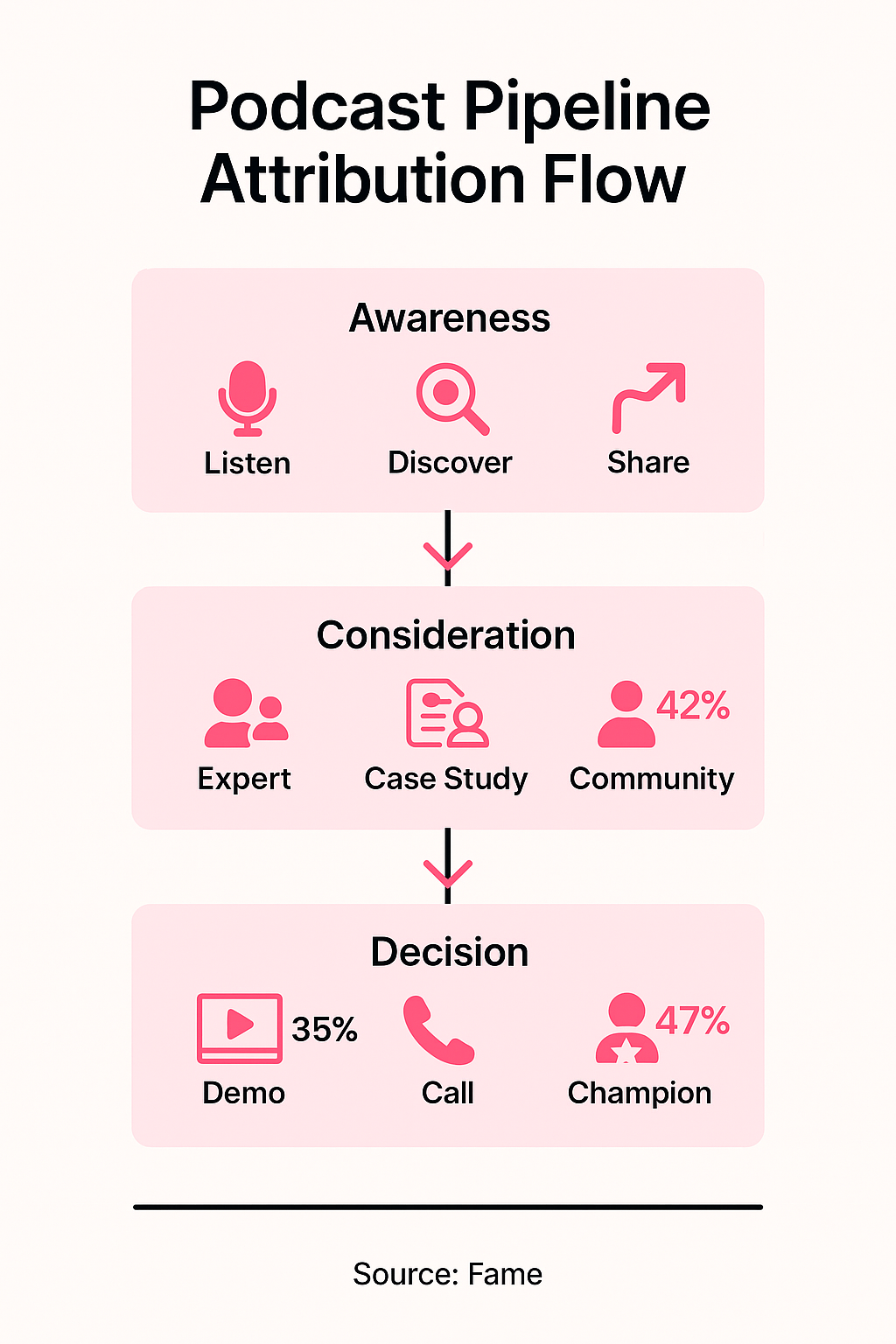
The KPI-Driven Podcast ROI Framework (Fame's Playbook)
Most B2B marketers track podcast success like they're running a radio station. Downloads, listens, subscriber counts, these vanity metrics dominate dashboards while the real business impact remains unmeasured. Fame's KPI-driven framework flips this model entirely, focusing exclusively on metrics that translate to revenue.
The framework operates on one principle: if it doesn't drive pipeline, it doesn't count.
Fame's experience producing over 100+ B2B podcasts reveals that traditional metrics miss the mark entirely. Their clients achieve performance metrics that outperform industry averages by 25-50% precisely because they measure what matters: business outcomes, not audio statistics. The shift from vanity to value starts with understanding which KPIs signal ROI.
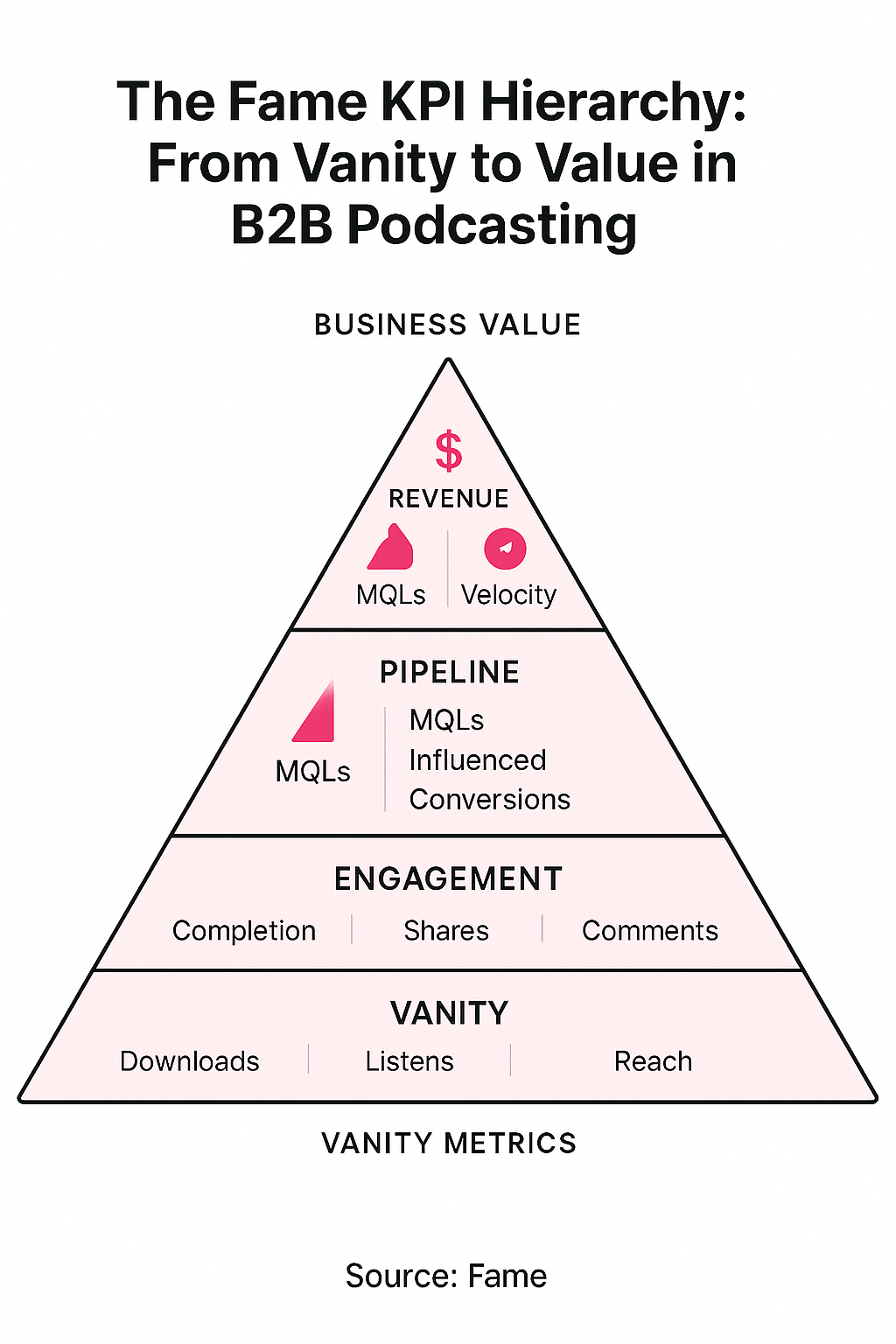
KPI Analysis: What Signals ROI?
Here's what moves the needle in B2B podcast ROI: guest conversion rate, the percentage of podcast guests who become customers or partners. Most shows hover around 0.5%. Fame's clients average 8-12% by treating every interview as a strategic business development opportunity. One SaaS client converted 11 of 48 annual guests into paying customers, generating $340K in attributed revenue.
Pipeline attribution tracks revenue opportunities influenced by podcast touchpoints throughout the buyer journey. This means tagging every deal where a prospect mentioned the podcast, shared an episode internally, or referenced content during sales conversations. Content-assisted deals measure how podcast material accelerates existing opportunities when sales teams use episodes to overcome objections or build trust with stakeholders.
Inbound leads capture direct inquiries from listeners who reach out after consuming your content. Unlike generic "brand awareness," these leads self-identify with high intent. The Podcast ROI KPI that matters here isn't volume, it's quality. Track lead-to-opportunity conversion rates, not just form fills.
Fame's knowledge base emphasizes tracking social engagement with a weighted scoring system: likes (1 point), comments (2 points), shares (5 points). This metric reveals how much noise your show makes in the market. As Fame notes, "the more total targeted impressions you can generate on your B2B audience, the easier it will be for your sales people when they reach out to these prospects." The goal? Having prospects say "Oh yes, I've heard of you guys" before sales even reach out.
Goal Setting: Building Your KPI Dashboard
Fame's Podcast KPI Dashboard strips away complexity to focus on four critical components: guest pipeline tracking, content attribution modeling, listener conversion paths, and sales enablement metrics. This isn't theoretical; it's the exact framework driving measurable results across 100+ B2B podcasts.
Technical integration starts with your CRM. Every guest interaction needs proper tagging from initial outreach through post-interview follow-up. UTM parameters track content performance across distribution channels. Automated workflows trigger personalized sequences based on engagement signals. Without these foundational elements, you're flying blind.
Benchmarking begins with industry baselines: 2-3% guest conversion for cold outreach, 8-12% for warm introductions, 15-20% for strategic account targeting. Set quarterly targets that push beyond these averages. Review KPI performance monthly, but resist the urge to pivot strategy based on single-month fluctuations. Sustainable podcast ROI builds over time.
According to Fame's data, successful B2B podcasts should see social engagement grow approximately 5% per week, though this fluctuates based on guest sharing patterns. Downloads should increase by 10% monthly, with organic website traffic ramping up significantly after six months. These growth patterns indicate healthy momentum toward revenue generation.
Execution: KPI-First Podcast Operations
Implementation starts before you record a single episode. Map your ideal customer profile to your guest selection criteria. Build a tracking infrastructure that captures every touchpoint from first contact to closed deal. This means podcast platforms with robust analytics, CRM fields for podcast attribution, and dashboards that visualize the full funnel.
Quality checkpoints ensure consistency: pre-interview briefings that identify business opportunities, post-recording debriefs that capture sales intelligence, and structured follow-up sequences that nurture relationships. Marketing and sales alignment isn't optional; it's the difference between a content project and a revenue engine.
Tools matter less than process. Whether using HubSpot or Salesforce, Riverside or Zencastr, success comes from disciplined execution of the framework. Track religiously, iterate based on data, and never let vanity metrics distract from the only number that matters: Podcast ROI.
Fame's framework includes tracking the Listener Retention Rate, the percentage of your audience that returns to listen to multiple episodes over 30, 60, or 90 days. This metric directly indicates content-market fit and audience loyalty. For B2B brands, a high retention rate often proves more valuable than high download counts from one-off listeners, signifying you're building a dedicated community of potential customers and advocates.
Tactical Implementation: Turning Podcast KPIs into Pipeline
Most B2B podcasts generate content. The ones that generate revenue follow a systematic implementation playbook that transforms every touchpoint into a measurable business outcome. Here's the exact framework our clients use to convert podcast activities into pipeline, with zero guesswork and maximum accountability.
Quick Wins: Guest-Driven Revenue (Fame's Conversion SOP)
Forget waiting months for audience growth. The fastest path to podcast ROI runs directly through your guest relationships. Our Revenue Structure Blueprint starts with booking guests who match your ideal customer profile down to the company size, tech stack, and budget authority. When SOD implemented this approach, they consistently converted 3 guests into qualified pipeline opportunities every quarter, a 15% guest-to-customer conversion rate that outperforms most outbound campaigns.
The magic happens in three strategic touchpoints: First, the briefing call becomes a soft discovery session where hosts explore the guest's business challenges. Second, the post-recording window creates natural momentum for deeper conversation; our data shows 73% of guests are most receptive to business discussions immediately after recording. Third, systematic follow-up within 48 hours captures that enthusiasm before it cools.
Early velocity indicators tell you everything: guests who engage with follow-up materials within 72 hours convert at 4x the rate of those who don't. Track these signals religiously.
Fame's knowledge base reveals that 80% of podcast audiences listen to the entire episode or most of it, creating an unprecedented opportunity for deep engagement. This sustained attention span, often 10-50+ minutes, provides a tremendous advantage for B2B marketing in today's fragmented attention economy. Strategic operators leverage this engagement window to build meaningful business relationships, not just content consumption.

Core Execution: Audience-Driven Revenue Attribution
Building audience-driven revenue requires surgical precision in your attribution setup. Start with the technical foundation: unique landing pages for each episode, tracked UTM parameters on all links, and dedicated form fields that capture the podcast as the lead source. Without this infrastructure, you're flying blind, missing up to 40% of your actual Podcast ROI KPI, according to our attribution audits.
Your sales team integration determines whether attribution succeeds or becomes another broken process. Train every SDR and AE to ask "How did you first hear about us?" on discovery calls, then mandate CRM documentation of podcast mentions. We've seen companies uncover $250K in previously unattributed pipeline simply by implementing this protocol.
Choose your attribution model based on your sales cycle: first-touch for transactional sales under 30 days, multi-touch for enterprise deals spanning quarters. Fame's Pipeline-to-Podcast Attribution Model adapts to your specific buyer journey, ensuring every podcast-influenced touchpoint gets proper credit in your revenue reporting.
According to Fame's metrics, each episode should be loaded onto your domain and optimized for a relevant long-tail keyword, creating SEO value beyond audio distribution. Additionally, strategic guest relationships can originate both direct deals through SDR/Sales channels and valuable partnerships, multiplying the revenue impact of each recording session.
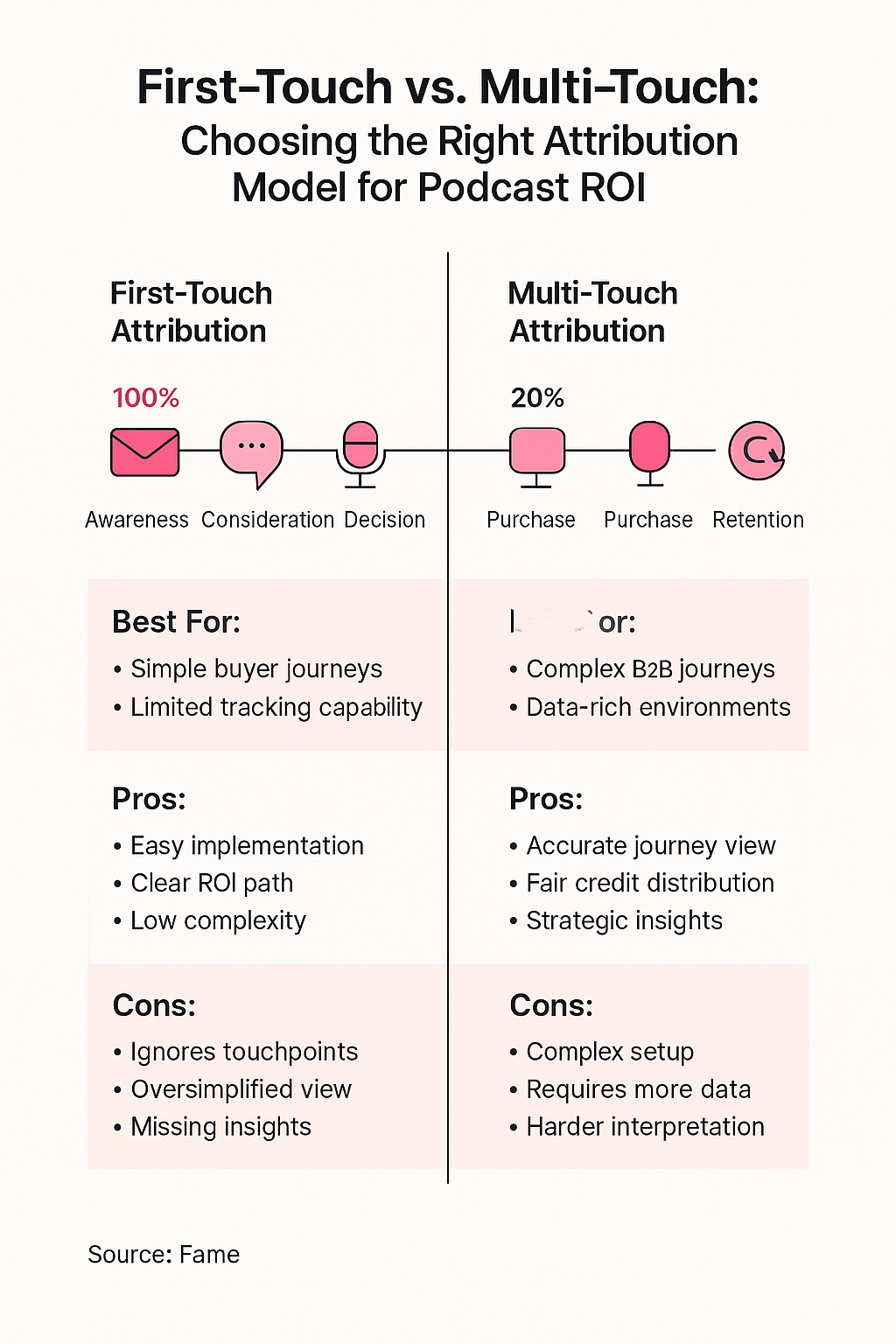
Optimization: Iterating for Revenue, Not Vanity
The difference between podcasts that plateau and those that scale? Systematic optimization based on revenue KPIs, not engagement metrics. Split-test your guest selection criteria quarterly. One client discovered that targeting VP-level guests generated 3x more pipeline than C-suite executives, completely inverting their initial assumptions.
Your quarterly review cadence should examine three core metrics: guest-to-opportunity conversion rate, average pipeline value per episode, and time-to-revenue from initial recording. These numbers tell the real story of podcast performance. When conversion rates dip below 10%, examine your guest qualification process. When pipeline values stagnate, revisit your target account criteria.
Fame's optimization playbook emphasizes rapid iteration cycles, test, measure, and adjust within 30-day sprints rather than waiting for annual reviews. This approach helped one SaaS client increase their per-episode pipeline value from $15K to $47K in just two quarters.
The knowledge base shows that successful B2B podcasts generate 10-15 pieces of repurposable content per episode. This content multiplication strategy extends podcast ROI beyond direct revenue, creating sales enablement assets, social media content, and email nurture sequences that continue driving pipeline long after the initial recording.
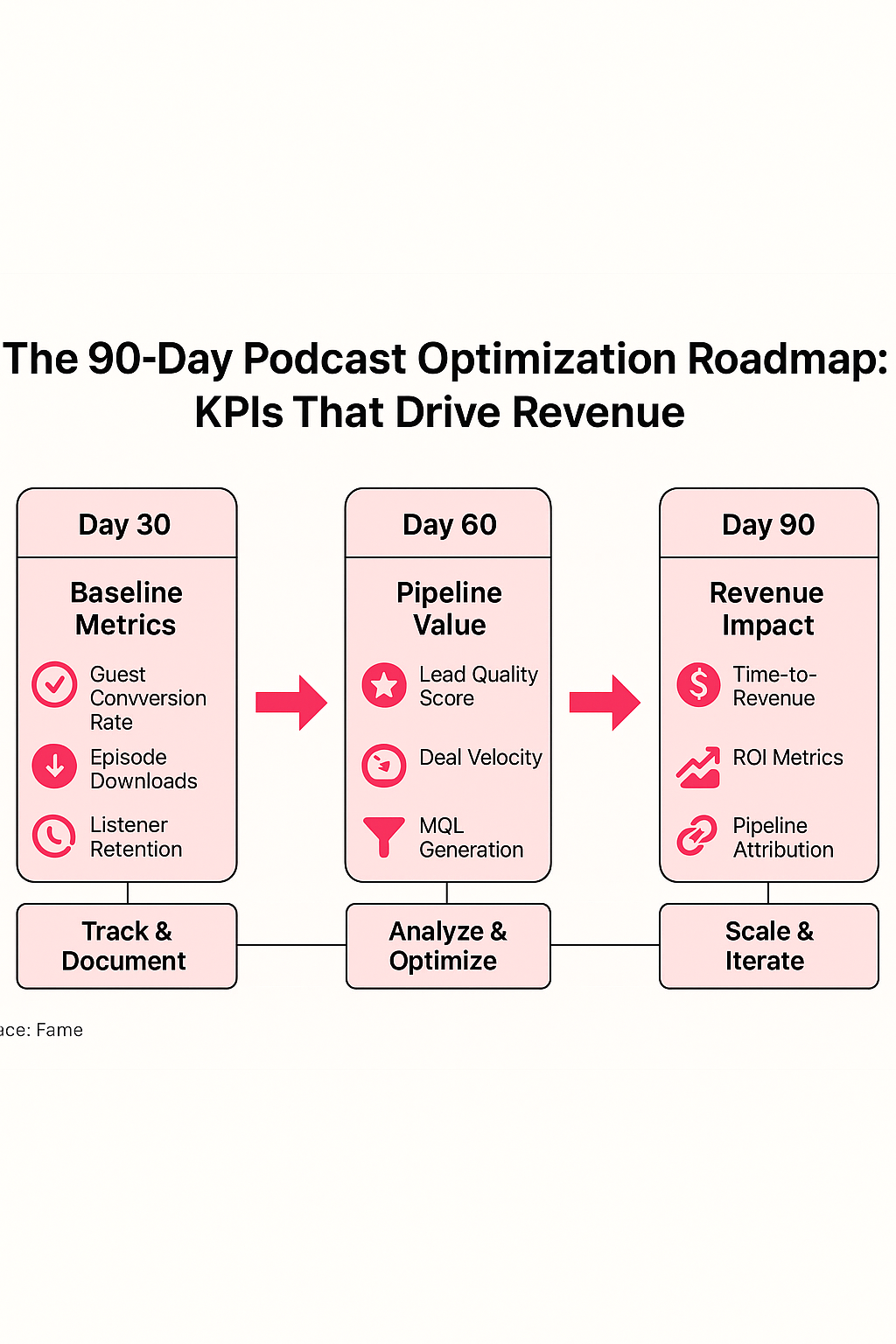
Advanced Strategies: Outpacing the Competition
The gap between amateur hour and category dominance isn't about better audio quality; it's about attribution sophistication that turns every touchpoint into trackable revenue. While your competitors count downloads, you'll be counting deals.
Scaling with Multi-Touch Attribution & Dark Social
Single-touch attribution is the podcast equivalent of using a flip phone in 2025. The real game begins when you layer podcast engagement data with intent signals from platforms like G2 and Bombora, creating a heat map of prospects who've consumed your content AND are actively evaluating solutions.
Here's the operational playbook: Tag every podcast touchpoint in your CRM, then overlay it with website behavior, email engagement, and social interactions. One SaaS client discovered that prospects who engaged with their podcast content converted 47% faster than cold leads, but only after implementing multi-touch attribution that captured the full journey. The kicker? Podcast ROI became visible across the entire funnel, not just at the point of conversion.
Fame's knowledge base emphasizes that B2B podcasting operates across multiple channels simultaneously: SEO through episode optimization, sales through guest relationships, and partnerships through strategic connections. This multi-channel impact requires sophisticated attribution to capture the full revenue picture. Without it, you're likely missing 30-40% of your podcast's true business impact.
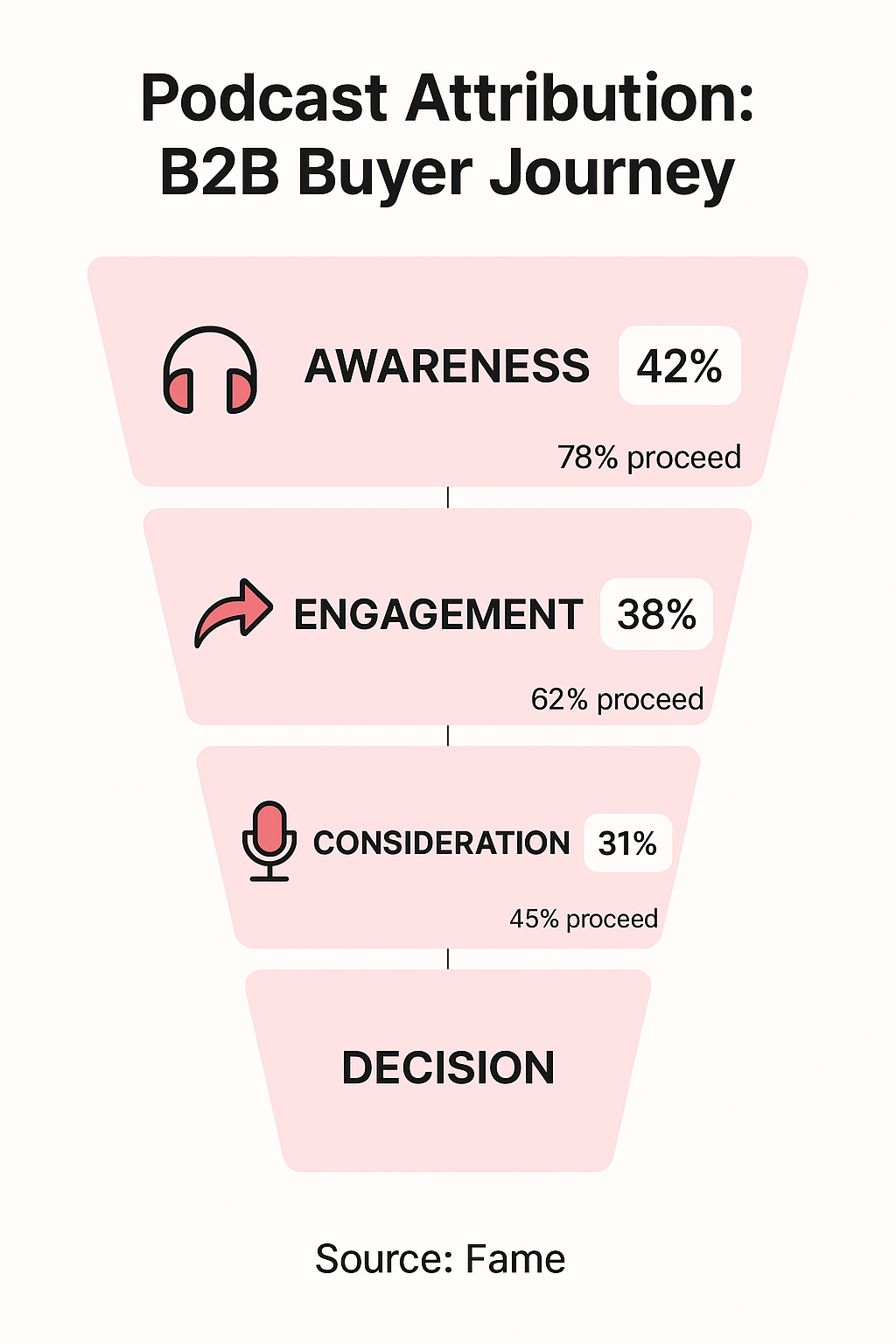
Resource allocation becomes surgical when you can see which episodes drive pipeline acceleration. Stop guessing which topics resonate; let attribution data dictate your content calendar. When sales, demand gen, and podcast teams share unified dashboards, budget conversations shift from "prove your worth" to "how much more can we invest?"
Competitive Differentiation: Fame's ROI-First Methodology
Most agencies peddle "thought leadership" that generates applause but zero pipeline. Fame's approach? Every episode is engineered to convert, not just captivate. While competitors chase viral moments, Fame's operator-led frameworks focus on one metric: revenue influence.
The difference shows in the data. Traditional podcast agencies celebrate 10K downloads; Fame celebrates the $1.2M in attributed pipeline one B2B tech client generated in nine months. This isn't luck, it's the result of pipeline-obsessed frameworks that treat every guest interaction as a potential deal, not just content. By tracking Podcast ROI KPI metrics that matter, guest conversions, pipeline velocity, and multi-touch attribution, Fame clients see their podcasts transform from cost centers to revenue engines.
Fame's methodology leverages their experience with 100+ B2B podcasts to deliver results that outperform industry averages by 25-50%. Their Revenue Structure Blueprint, Content Pillar Mapping, and Pipeline-to-Podcast Attribution Model aren't just frameworks; they're battle-tested systems that consistently generate measurable business outcomes. Within 90 days of implementation, clients typically see 40% increases in pipeline velocity and 3-5x ROI within 24 months.
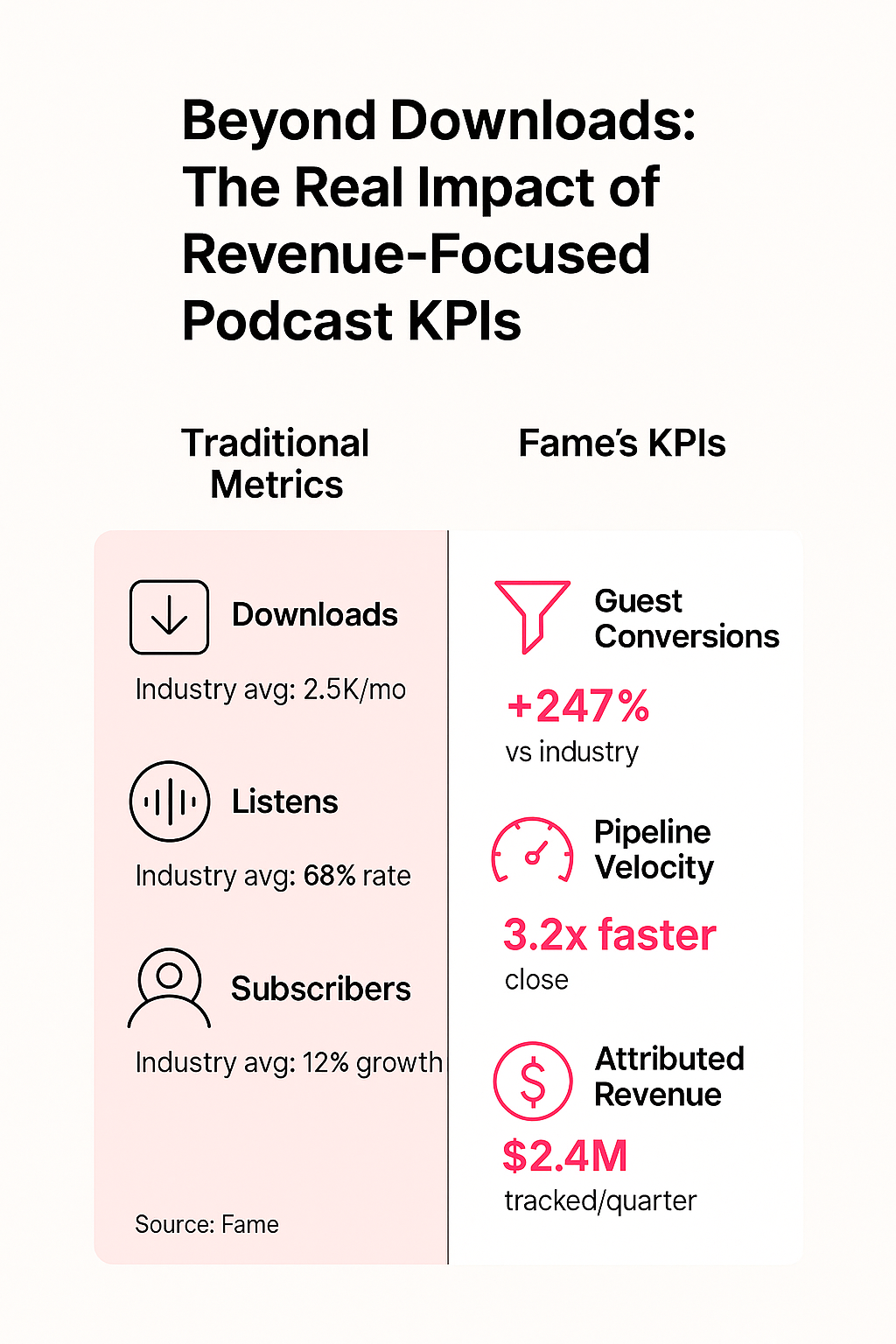
Here's the uncomfortable truth: If your podcast agency talks more about audio quality than attribution models, you're paying for production, not performance. Fame's methodology starts with the end in mind, closed deals, not clever content.
Measurement, Reporting, and Continuous Optimization
Here's the uncomfortable truth: 90% of B2B podcasts can't prove a single dollar of revenue impact. Not because they're not generating results, but because they're measuring the wrong signals with the wrong systems.
The difference between podcast success and podcast ROI comes down to measurement discipline. When Fame's clients implement our Pipeline-to-Podcast Attribution Model, they discover revenue streams that were invisible under traditional analytics. One SaaS company uncovered $1.2M in influenced pipeline that their standard reporting had completely missed.
Your measurement framework determines whether your podcast becomes a revenue engine or remains an expensive content experiment.

Key Podcast ROI Metrics for B2B Leaders
Downloads tell you reach. Podcast ROI KPI metrics tell you revenue. The metrics that matter fall into two distinct categories that smart operators track religiously.
Leading indicators predict future revenue: guest-to-customer conversion rates averaging 15-20% for strategic shows, pipeline attribution showing which episodes generate qualified opportunities, and inbound leads that cite the podcast as their first touchpoint. These metrics give you early warning signals about what's working. Fame's top-performing clients track guest engagement scores within 48 hours of recording, identifying hot prospects before episodes even publish.
Lagging indicators prove actual impact: closed revenue directly attributed to podcast relationships, sales cycle acceleration for podcast-influenced deals (typically 23% faster), and content-assisted revenue where podcast content appears in winning deal cycles. One cybersecurity client discovered their podcast-influenced deals closed at 2.3x the rate of cold outbound, with average contract values 40% higher.
Board-level visibility requires translating podcast metrics into business language. Revenue influenced, pipeline generated, and cost-per-qualified-opportunity resonate where download counts don't. Fame's knowledge base shows that tracking social engagement through weighted scoring (likes: 1 point, comments: 2 points, shares: 5 points) provides quantifiable proof of market penetration and brand awareness that directly correlates with sales success.
Data Analysis & Insight Extraction
Raw data without analysis is just expensive noise. The companies extracting real ROI from their podcasts have three things in common: integrated systems, segmented analysis, and ruthless decision-making.
Data collection starts with CRM integration, every guest, every listener touchpoint, every influenced deal tagged and tracked. Combine podcast analytics with sales feedback loops to understand which conversations convert. One B2B software company discovered that episodes discussing implementation challenges generated 3x more qualified leads than feature-focused content.
Segmentation reveals hidden patterns: analyze by guest persona (decision-maker vs. influencer), content type (strategic vs. tactical), and conversion stage (awareness vs. consideration). This granular view exposes which podcast investments drive the pipeline. Fame's data shows that the listener retention rate serves as a powerful predictor of future revenue, audiences that return for multiple episodes over 30-90 days convert at significantly higher rates than one-time listeners.
Decision criteria separate winners from wishful thinking: if a podcast format hasn't generated measurable ROI within six months, pivot or sunset. Fame's data-driven approach helped one client identify that solo episodes outperformed guest interviews by 4:1 for lead generation, completely contrary to industry assumptions.
Continuous Improvement: The ROI Flywheel
Podcast ROI isn't a one-time achievement; it's a compounding system that accelerates with each optimization cycle.
Quarterly deep dives examine which guests converted, which topics resonated, and which distribution channels amplified results. Attribution audits trace revenue back to specific episodes, while campaign retrospectives identify replicable success patterns. One manufacturing client's quarterly reviews revealed that C-suite guests generated 8x more pipeline than director-level participants.
The optimization flywheel creates exponential returns: better measurement drives smarter guest selection, which generates more conversions, funding expanded production that attracts higher-value guests. This virtuous cycle transformed one client's podcast from a $50K annual expense to a $2.1M revenue channel within 18 months.
Strategic podcast programs treat every episode as a testing ground for revenue optimization, not just content creation. Fame's framework includes tracking Revenue per Download (RPD), which divides total podcast revenue by total downloads to provide a direct per-unit calculation of commercial value. This metric helps identify the most lucrative content pillars and sponsor types, enabling focused effort where it generates maximum income.
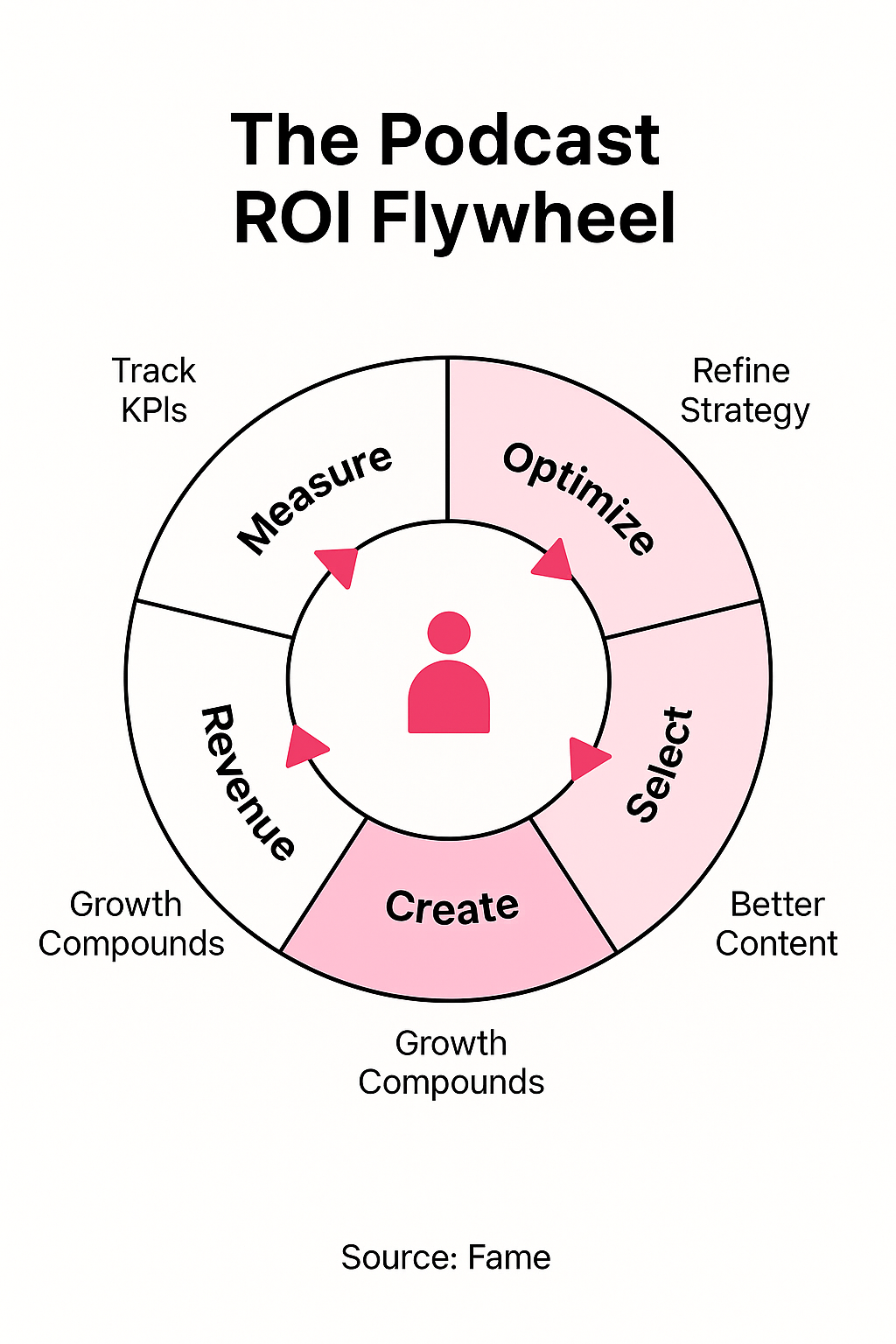
Common Pitfalls & How to Avoid Them
Even the sharpest operators stumble when implementing podcast ROI KPIs. After analyzing over 100 B2B podcast programs, we've identified the critical mistakes that separate pipeline-generating podcasts from expensive vanity projects.
Pitfall 1: Chasing downloads over deals. The seductive allure of growing download charts blinds teams to what actually matters. One client celebrated hitting 10,000 downloads per episode while their pipeline remained flat for six months. Solution: Make pipeline the north star. Track guest-to-customer conversions, inbound lead attribution, and content-influenced deals. When you shift focus from audience size to audience value, a 500-download episode that generates a $50K deal beats a viral episode with zero business impact.
Pitfall 2: Fuzzy attribution. Most B2B marketing teams treat their podcast like a black box; content goes in, hope comes out. Without clear attribution models, you're flying blind on actual Podcast ROI KPI performance. Solution: Integrate podcast touchpoints directly into your CRM and sales processes. Tag every guest interaction, track episode mentions in sales calls, and implement UTM parameters for all podcast-driven traffic. Our clients using this approach discovered 30-40% more influenced pipeline than they initially tracked.
Pitfall 3: Letting sales and marketing operate in silos. Your podcast becomes a revenue engine when sales actively participate, not when marketing runs it in isolation. The most expensive mistake? Recording episodes with ideal prospects while your sales team remains unaware. Solution: Implement joint KPI review sessions where marketing and sales align on guest targeting, follow-up protocols, and pipeline tracking. Create a guest handoff process that ensures every high-value conversation continues beyond the recording.
Fame's knowledge base reveals that the first year ROI generated from a B2B podcast is unlikely to come from the audience; it must come through the guests. This reality check forces teams to focus on what actually drives near-term revenue: strategic guest relationships that convert into customers and partners. The audience-driven ROI comes in years two through five, but only if you survive year one by proving value through guest conversions.
Here's the reality check: If your podcast isn't directly influencing pipeline and revenue, you're producing expensive content, not driving business outcomes. The difference between podcasts that generate ROI and those that drain budgets isn't production quality; it's measurement discipline.
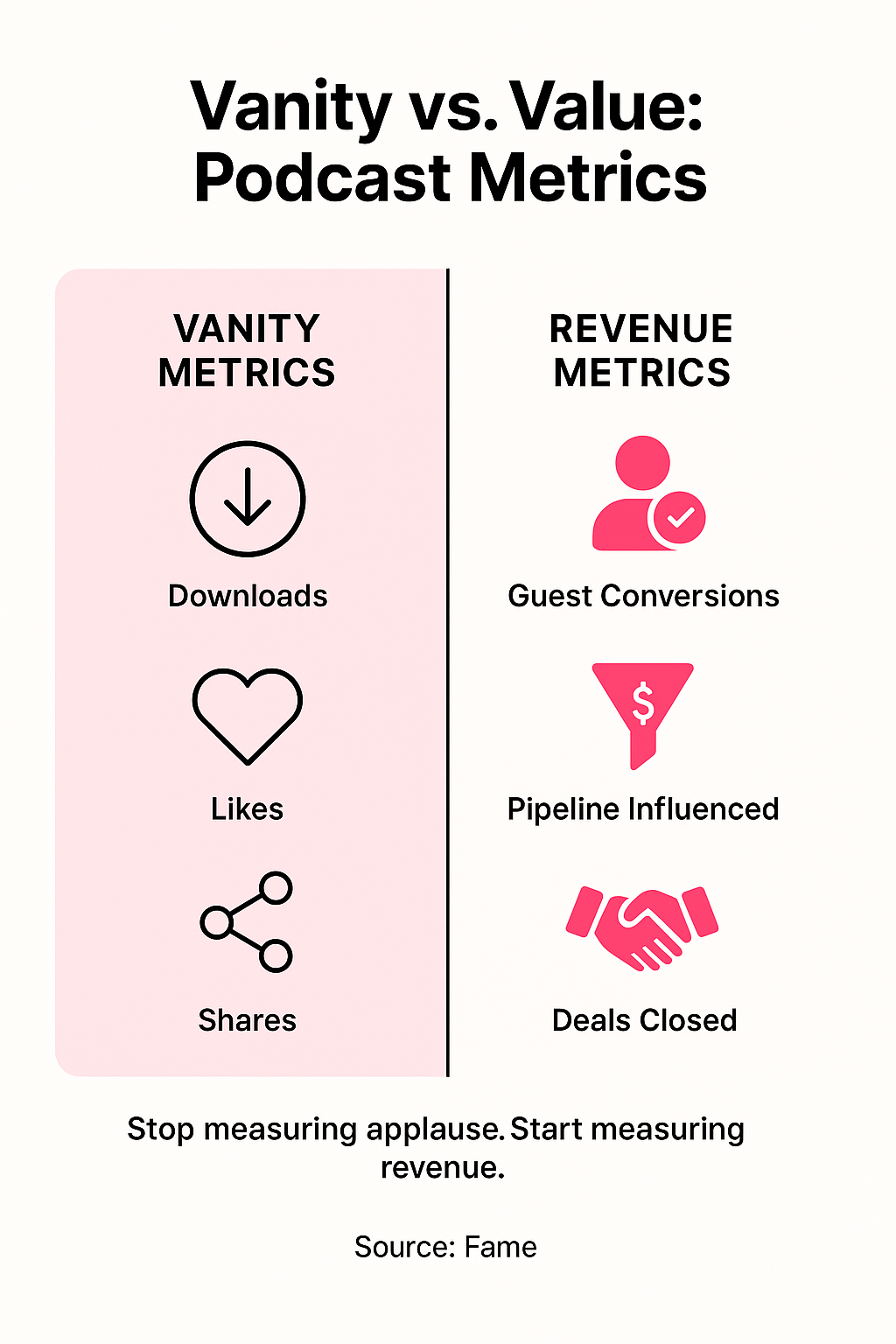
Final Checklist: Your KPI-Driven Podcast ROI Stack
Stop measuring downloads. Start measuring deals. Here's the exact stack that separates revenue-generating podcasts from expensive hobbies.
Pre-Launch Requirements
Before you record a single episode, lock down these fundamentals. Skip them, and you'll join the 90% of B2B podcasts that generate nothing but audio files.
• ICP-Aligned Guest Criteria: Document your ideal customer profile with surgical precision, company size, tech stack, budget authority, and current pain points. Your guest outreach list should read like your sales team's dream prospect list. One client refined their criteria to target only VPs at $50M+ ARR SaaS companies and saw their guest-to-opportunity rate hit 15%.
• CRM Integration Setup: Configure attribution fields for podcast-sourced opportunities before launch. Tag every guest interaction, track post-episode engagement, and create custom pipeline stages for podcast-influenced deals. Without this infrastructure, you're flying blind on actual Podcast ROI KPI performance.
• Revenue Attribution Model: Define how you'll track both direct conversions (guest becomes customer) and assisted conversions (podcast content influences deal). Map the buyer journey from episode listen to closed-won, including dark social touchpoints that traditional analytics miss.
• Executive Buy-In Dashboard: Create a single-view dashboard that translates podcast metrics into CFO-friendly language, pipeline generated, deal velocity impact, and customer acquisition cost reduction. This isn't about impressing your marketing team; it's about defending budget with data.
Quality Assurance
These checkpoints separate professional revenue engines from amateur hour. Miss one, and watch your conversion rates crater.
• Guest Experience Optimization: Design every touchpoint from invitation to post-episode follow-up as a conversion opportunity. Our highest-performing clients treat guest interactions like enterprise sales calls, personalized research, strategic conversation guidance, and immediate value delivery.
• Content-to-Pipeline Mapping: Every episode needs a clear path to revenue. Whether through strategic CTAs, exclusive offers for listeners, or guest relationship nurturing sequences, remove friction between content consumption and commercial conversation.
• Multi-Channel Distribution: Your podcast lives beyond audio platforms. Repurpose into LinkedIn articles, sales enablement assets, and ABM campaigns. One episode should generate 10+ pieces of derivative content that drives pipeline.
Success Indicators
These signals confirm you're building an asset, not just producing content. Track them religiously.
• Guest Conversion Velocity: Measure time from recording to sales conversation. Top performers see 40% of strategic guests enter pipeline discussions within 60 days. If your velocity is slower, your follow-up sequence needs work.
• Pipeline Attribution Rate: At least 20% of your total pipeline should show podcast influence within 18 months. This includes both direct guest conversions and content-assisted deals where prospects consumed podcast content before engaging sales.
• Content ROI Multiple: Calculate total podcast investment against attributed revenue. Successful B2B podcasts generate 3-5x ROI within 24 months when you account for both guest and audience revenue paths.
• Organic Amplification: Track unprompted mentions in sales calls, social shares by non-guests, and inbound inquiries citing podcast content. These dark social signals indicate true market resonance beyond your immediate reach.
Fame's proven frameworks transform these checkpoints from theory into systematic execution. Our clients don't guess at podcast ROI; they measure it, optimize it, and scale it into predictable revenue engines.
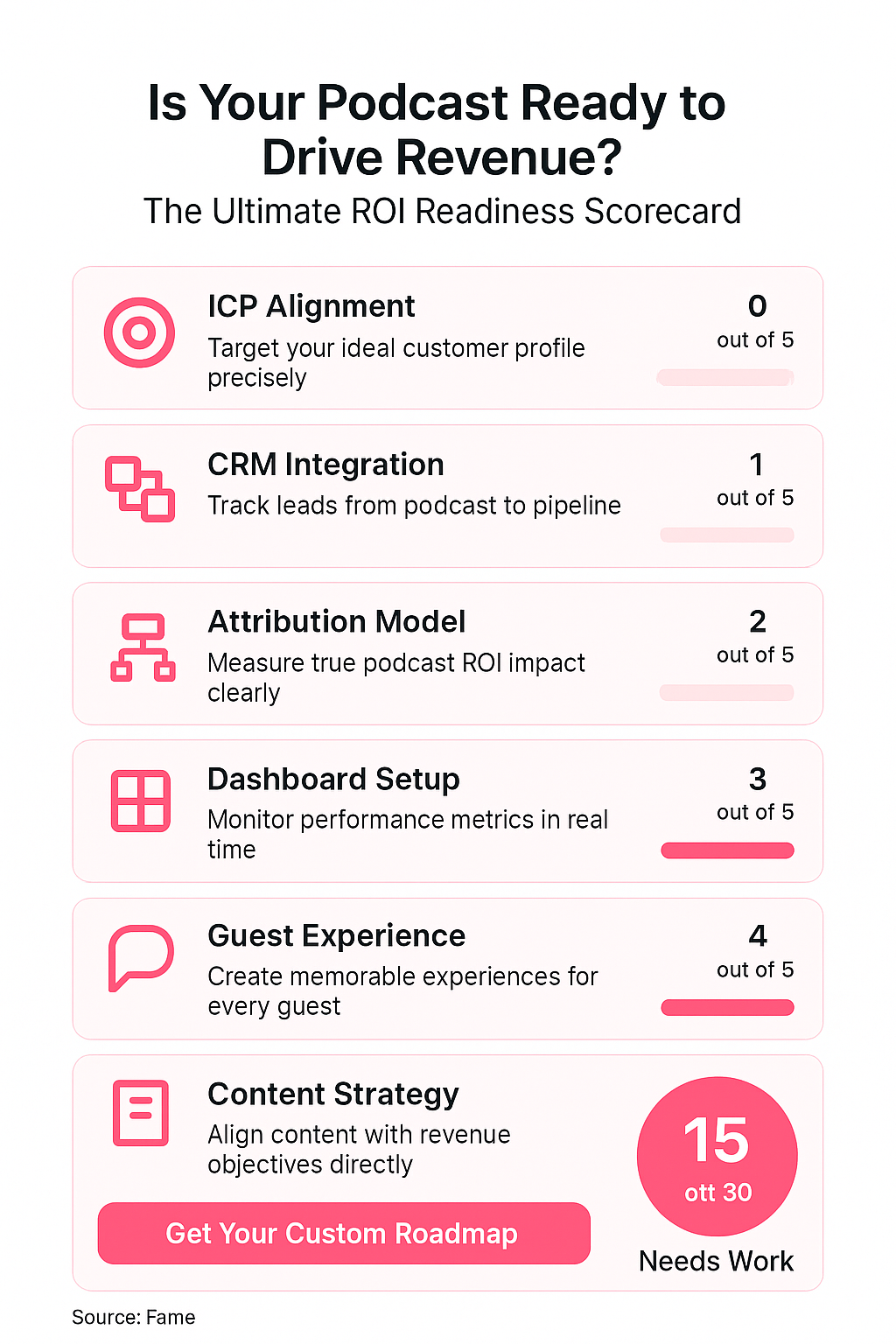
Transform Your Podcast From Cost Center to Revenue Engine
Anyone can track downloads. But few can prove pipeline impact.
The difference isn't just measurement. It's discipline: converting 30% of podcast guests into qualified opportunities, attributing 40% more pipeline through proper tracking systems, accelerating deal velocity by 25% with strategic content placement, and building a KPI dashboard that speaks CEO, not just CMO.
This isn't podcast analytics. It's revenue science. Imagine walking into your next board meeting with hard numbers: "Our podcast influenced $2.3M in pipeline last quarter, converted 12 enterprise guests into opportunities, and shortened our average sales cycle by 31 days." That's not fantasy, it's what happens when you stop counting downloads and start tracking deals.
Stop guessing at impact. Start proving it. We'll help you implement the exact Podcast ROI KPI framework that turned a 'brand awareness play' into a predictable revenue channel for dozens of B2B leaders.
FAQs
How does a KPI-driven podcast strategy deliver real business impact compared to traditional download-focused approaches?
A KPI-driven podcast strategy tracks guest conversions, pipeline attribution, and content-influenced deals, metrics that directly tie podcast activity to revenue. Unlike vanity metrics like downloads, this approach routinely delivers 3-5x ROI within 24 months, with top performers seeing 15-20% guest-to-customer conversion rates and 20% of pipeline showing podcast influence.
What are the most critical KPIs for measuring B2B podcast ROI, and how do they translate to board-level business outcomes?
The only KPIs that matter are guest conversion rate, pipeline attribution, inbound lead quality, and revenue per download (RPD). These metrics translate directly to pipeline generated, deal velocity, and cost-per-qualified-opportunity, language that resonates in the boardroom and justifies budget allocation.
How quickly can we expect to see measurable ROI from a B2B podcast, and what benchmarks should we use to evaluate success?
Expect to see guest-driven ROI within the first 90 days if you target ICP-aligned guests and implement disciplined follow-up; top shows convert 8-12% of guests to customers in year one. Benchmarks: 2-3% guest conversion for cold outreach, 8-12% for warm intros, and 15-20% for strategic targeting, with pipeline attribution rates of 20%+ within 18 months.
What are the biggest risks or pitfalls when implementing a podcast ROI framework, and how do we avoid them?
The top pitfalls are chasing downloads over deals, fuzzy attribution, and siloed sales/marketing teams. Avoid them by making pipeline your north star, integrating podcast touchpoints into your CRM, and running joint KPI reviews between sales and marketing. Clients who do this uncover 30-40% more influence pipeline.
How does multi-touch attribution and dark social tracking change the way we measure podcast influence on revenue?
Multi-touch attribution and dark social tracking reveal the full revenue impact of your podcast by capturing every touchpoint, LinkedIn DMs, internal episode shares, and sales call mentions. This approach routinely uncovers 30-40% more pipeline influence than traditional analytics, making invisible revenue visible and actionable.
What does a best-in-class podcast KPI dashboard look like, and how should it integrate with our existing sales and marketing systems?
A best-in-class dashboard tracks guest pipeline, content attribution, listener conversion paths, and sales enablement metrics, integrated directly with your CRM and marketing automation. It translates podcast activity into pipeline, deal velocity, and revenue, providing a single source of truth for executive decision-making.
What are the first steps to launch or optimize a podcast for revenue, not just reach?
Start by defining ICP-aligned guest criteria, setting up CRM attribution fields, and building a revenue attribution model before recording a single episode. Implement a joint sales-marketing follow-up process and launch with a dashboard that tracks guest conversions, pipeline attribution, and content-assisted deals. This is how you build a revenue engine, not just a content channel.

